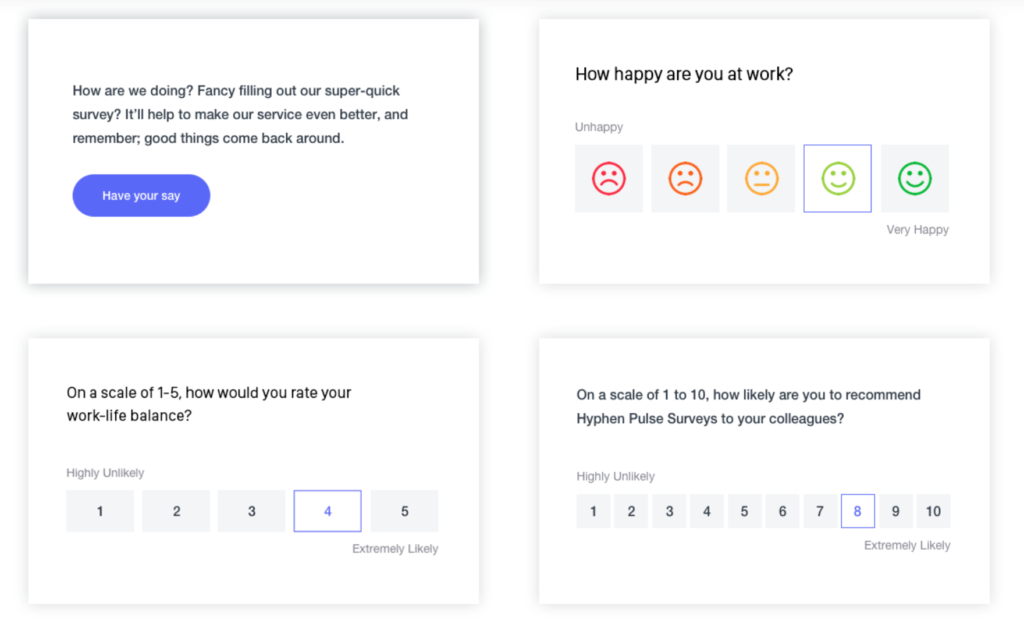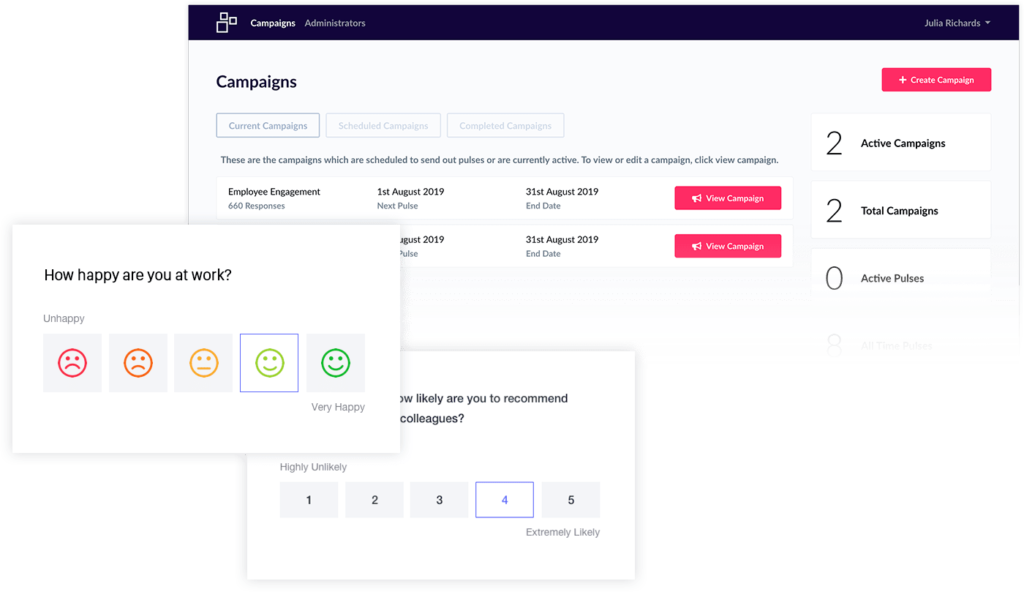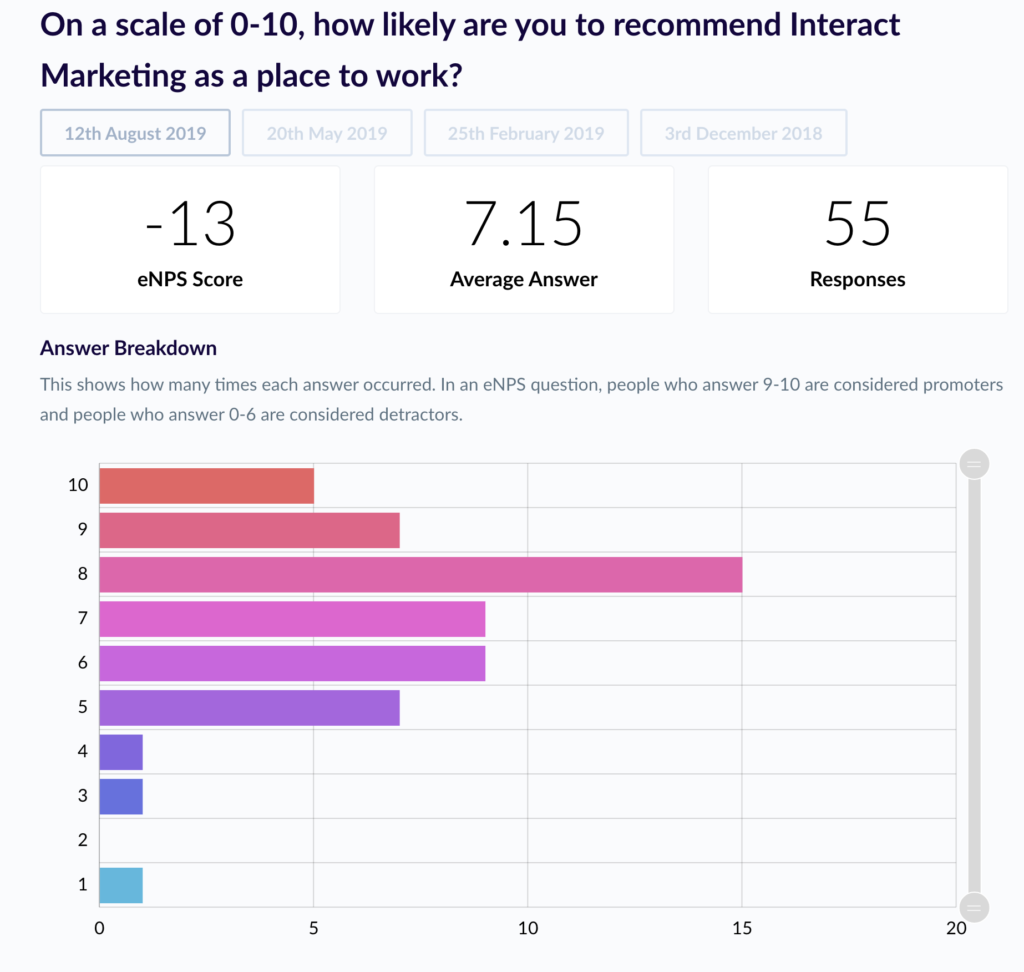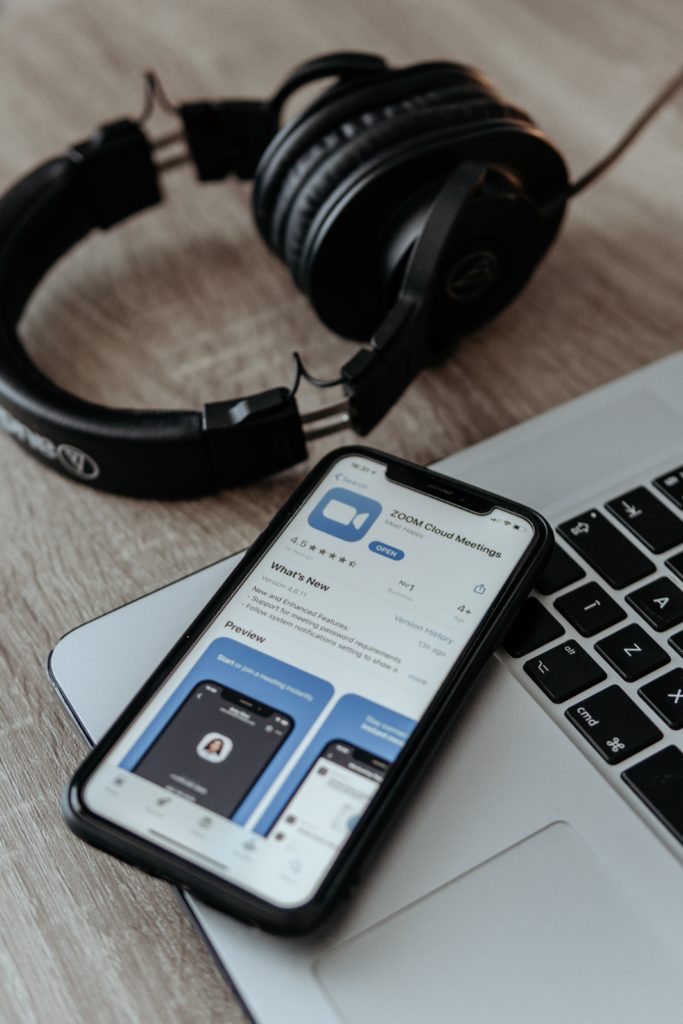How – and why – to create remote employee pulse surveys and check in with staff working from home
Large-scale remote working during the coronavirus pandemic is set to continue for some time, with some estimates putting a full ‘return to normal’ as far away as 2021. As organizations and staff alike realize the benefits, some analysts predict the demise of the traditional office-based working model entirely.
We can’t know for sure when – or if – staff will return to their desks as before. However, while the initial adjustment period may now be behind us, we must continue to evolve the remote work experience. Now is not the time for complacency.
Managers and HR teams still face challenges and increasing disconnect, as the move from offices to virtual workspaces has an undeniable impact on our cultures. Many organizations are also experiencing financial strain, changes in their processes, protocols, or service and product provision, along with furlough programs or potential permanent changes in headcount.
The implications for morale, engagement, productivity, staff loneliness, isolation, and well-being all need to assessing and managing accordingly.
Now, more than ever, we need to be listening to our staff and understand:
- How our employees are feeling and coping
- If they’re still aligned to the business and their immediate teams
- How to support them appropriately
Remote employee pulse surveys are a valuable and efficient way to tap into staff sentiment and determined how engaged, aligned, and supported your remote workforce is. Setting up these effective check-ins and feedback loops will not only support our staff in the current circumstances but ensure we have solid foundations for long-term remote work.
What is a remote employee pulse survey?
In the same vein as any pulse survey, these are short, concise, and specific surveys focusing on a particular area for improvement or insight.
Their value and benefit come from their brevity: usually of between one to ten questions, making them quick to design and answer, and increasing participation as a result. When done frequently – as opposed to annual employee surveys – they can provide real-time feedback and actionable insights.

When designed for remote workers, pulse surveys must focus on those challenges and priorities that affect them most: communication, connection to the organization, motivation or barriers to productivity, and overall engagement.
When used alongside conventional forms of internal and manager communication, pulse surveys can play a central role in managing the remote worker experience and identifying staff needs, particularly during times of change or uncertainty.
It’s important to remember when conducting any survey during the coronavirus pandemic that this is not typical remote working: we need a broader understanding of the unique circumstances facing our employees. Productivity is going to be below normal range; levels of anxiety or stress may be higher; there are additional distractions, including spouses, children, other family members.

Sensitivity in the questions put to employees must form part of your planning process: we can’t be copying and pasting from a previous survey template or defaulting to generic employee Net Promoter Scoring (eNPS).
When delivered in specific language framed for remote workers and their situation, however, a pulse survey can help managers gain understanding, insights, and remain connected to their direct reports.
Remote employee pulse survey best practice: things to consider
Before delving into the specific questions, it’s worth considering a few best practices to help you get the most from your survey and those completing it.
When designing your remote employee pulse survey, be clear in your objectives and what it is that you’re looking to learn. Pick a theme or area of focus, working backward from the information you’re looking for to design the questions that can help obtain it. Trying to tackle multiple topics in one go may overwhelm staff and fail to produce the results you’re looking for.

For example, are you looking to understand the mental wellbeing of your staff and how they’re coping? If your efforts as an organization to support them with remote working are sufficient? Perhaps it’s to determine their level of engagement and connection to your organization, or even their readiness to return to office work further down the line.
Avoid being swayed by stereotypes or making assumptions that would steer your remote employee pulse survey incorrectly. Expecting a particular outcome before you even ask the question may inadvertently create bias in question-wording or who you choose to send it to.
For example, there is a long-standing misconception that remote workers are more likely to ‘underwork’ or not complete their hours. Research suggests it’s the opposite, with many remote workers working longer hours in a bid to prove their output and worth.

At a time when many are concerned about job security or financial situation, there’s an even higher risk that your staff may be feeling under pressure to work longer or losing the boundary between their home and work life. Staff must not feel they are being ‘checked up on’: there’s a risk that when assuming the outcome, it will come across in how you design the pulse survey.
Communicate the purpose of your survey with your staff: why their participation is important and what’s in it for them, in terms of the actions you would look to take based upon the results.
Ensure it’s as simple as possible to answer, ideally through a channel or platform they already know well – such as your intranet – and that language used is clear and neutral.

Consider the frequency you’ll be sending out your pulse survey. If there is a trend, theme, or area of concern that you’re looking to track over a period of time – such as employee sentiment or mental wellbeing during lockdown – determine how often those checkpoints need to be to capture that data.
Only send it out as fast as you can act. If staff are filling out your survey and anticipating action from the organization only to be asked to complete another without seeing change, they’ll switch off. Lack-of-action fatigue can quickly undermine what you’re looking to achieve.
Finally, remember that your organization is unique: there is no one-size-fits-all, and remote employee pulse survey questions need designing in line with your culture, employee needs, and current circumstances in mind. Take an employee-focused approach.
Example remote employee pulse survey questions:
Depending on your pulse survey objectives, audience, and organizational culture, you may want to pick and change a few options to meet your needs. Remember not to overwhelm your employees, keeping your pulse survey succinct: between one to ten questions maximum. Focus on a particular theme where possible.
You also need to consider the remote employee pulse survey tool you’ll be using and how data will be collected, displayed, and analyzed. Asking thousands of employees open-ended questions with a free text box to answer, for example, maybe unworkable if you don’t have the resource or built-in analysis tools to evaluate the answers.

Some questions to consider include:
Theme: the company response to the current coronavirus pandemic
- {Company name} has communicated a clear plan of action in response to the coronavirus (COVIID-19) pandemic
- I feel well-informed about the steps {company name} is taking to protect the business and employees at this time
- I know who to approach/where to go for information if I have questions or concerns about the COVID-19 situation and {company name}
- I believe {company name} cares about its employees (Strongly agree, agree, not sure, disagree, strongly disagree)
- I understand the changes made to {company name}’s priorities/service provision/product line/other in response to the coronavirus pandemic
- The information given by {company name} about the current situation is clear and useful
Theme: setting up remote working
- I have access to the tools and information I need to perform my job at home well
- I have a remote working arrangement or setup that means I can work effectively from home
- I feel well-prepared to do my job at home
- I am satisfied with the remote working arrangements being made by {company name}
- I have all the necessary equipment I need (for example, IT equipment, office equipment) to work effectively at home

Theme: checking in with remote working parents
- {Company name} is supportive of parents working from home with dependents
- I can communicate openly with my manager regarding the balance of childcare and work
- My manager is supportive and adaptable to my circumstances as a parent working at home
- Me and my manager have a plan in place that allows me to balance my work and parental responsibilities effectively
- I feel the changes to my work responsibilities/working hours are realistic and enable me to work effectively as a parent with dependents at home
- I can the work expected of me/meet objectives set by my manager
- What can {company name} do to support you as a parent working from home with dependents? (Open answer)

Theme: individual workloads, goals, and time management
- My manager sets me clear objectives and goals to work towards
- I understand what I need to be working on to contribute to my team’s goals
- My workload is manageable in the current working circumstances
- The changes expected of me and how I perform my work from home are clear and reasonable
- I have sufficient time within my planned working hours to complete tasks assigned to me
- The work I am doing contributes to the wider goals of {company name}
Theme: Communication and connectivity
- My manager keeps in touch with me when I’m working from home
- There are plenty of opportunities for me to check in with my manager and team
- I feel well-connected to my direct team
- My direct teammates respond in a timely manner to enable me to carry out my work effectively
- I feel I understand what’s happening in other teams around the business
- I have good visibility of the broader projects happening within {company name}
- Other teams are reachable and receptive when I need their input
- Senior leadership does a good job of communicating regularly with employees
- {Company name} has a good level of internal communication to keep me informed and connected to the wider business

Theme: Mental well-being and isolation
- How would you rate your mental wellbeing right now?
- On a scale of 1 to 10 (10 being the highest), how would you rate your current stress levels?
- I feel supported by my manager
- I know who to turn to for help if needed
- Are you confident in where to access more mental health resources at {company name} ?
- I would feel confident raising any concerns about my mental wellbeing with my manager
- I have regular contact with others throughout my working day
- I have a good level of work-life balance whilst working at home

Open-ended discussion
- What’s the biggest challenge you’re facing with working remotely? (if any)
- What can your manager or team do to support you? {Open answer}
What do we do with the results?
Even more important than giving employees the opportunity to be heard is to show that your organization is listening.
Analyzing and acting on the data gained from your survey quickly demonstrates you’re taking your employees seriously. If you take no action, it will fuel distrust and discontent among your employees.

Review the results with managers and leaders in the first instance. Identify any clear trends, gaps, or weak points that should be put forward for immediate consideration. If you’ve run a baseline survey before, compare the data sets to see if there’s a notable shift in sentiment.
Depending on whether you’ve chosen to anonymize your remote employee pulse survey or if particular employee groups or demographics show differing results, you may need to have small group discussions with those to understand their challenges further. If you’ve got a low response rate, try and dig into why that is.

Some organizations share the results of their internal surveys, even if the outcome is perhaps unflattering. This embeds transparency and shows staff you’ve listened, creating a culture of trust. In our current circumstances, it may also provide much-needed reassurance for staff that they aren’t alone in how they’re feeling or experiencing this new reality.
Create a clear action plan to respond. This may be small, practical changes like checking people have the right equipment and applications they need, through to more substantial changes: such as rapidly deploying an intranet solution to improve internal communication, leadership visibility, and a sense of connection to the organization.
Pulse surveys for your remote employees, when combined with wider internal communications and line manager support, can prove an invaluable tool for checking in and giving staff a voice whilst operating at a distance.


